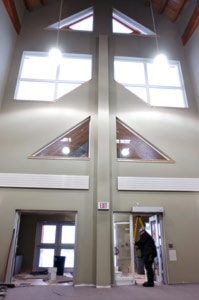The cost of the Canada Winter Games athletes’ village has increased to $34.4 million from $31 million.
The problems have mounted as well.
In fact, critics charge one of the two buildings could sit vacant for months — or even permanently — after the Games.
“The horse is out of the gate,” said acting NDP leader Steve Cardiff on Tuesday. “It’s way down the track. And the cart? They forgot to take it out of the shed.”
The problem boils down to municipal bylaws.
One of the two village buildings will be taken over by the Yukon Housing Corporation after the Games, and Jim Kenyon, the corporation’s minister, says it will be used for affordable housing.
But that requires the land the building sits on to be rezoned, a process that not only hasn’t been started, but which the city ultimately has the power to quash, said Cardiff.
“A lot more planning obviously needs to be done before this so-called ‘affordable’ housing becomes a reality,” he said during Question Period on Monday.
“The site that these buildings sit on doesn’t even have the correct zoning. Can the minister tell us when Yukon Housing Corporation intends to begin this process and what he plans to do if the city of Whitehorse exercises its lawful authority and turns down that zoning application?”
The housing corporation will make a decision on who will reside in the building in a few months, said Kenyon.
“It is not a political decision at any level,” said Kenyon.
The athletes’ village was built with features that allow the two identical buildings to accommodate a large range of tenants.
They are basically being “loaned” to the Canada Winter Games for two weeks before being used for the originally intended purpose, said Kenyon during his address to the throne speech on Monday.
“One will be turned over to the Yukon Housing Corporation and used for affordable housing; the other one will be turned over to Yukon College for an affordable family student residence,” he said.
But the lengthy rezoning process hasn’t been started.
At the moment, the two buildings sit on land zoned ‘public services.’
That allows them to be used as temporary shelters during the Games and as residences afterwards, but not as affordable housing units, said Whitehorse’s head planner Lesley Cabott.
“The official community plan and zoning bylaw do not allow for multi-family housing up there,” said Cabott. “There would need to be a community plan amendment and a rezoning. There are no services up there.”
The amendment process is complicated: if it were started tomorrow it could take four to six months to complete, she said.
The government was made aware that its plans for post-Games uses for the village could require rezoning more than 18-months ago, but has yet to apply for rezoning, said Cabott.
“They’ve always known they had to do it.”
The reason for the delays is that the Yukon Housing Corporation needs time to decide how to best use the buildings to meet current housing needs, said JoAnne Harach, government manager of the athletes’ village project.
“It’s not something we could have started in the spring of 2005 (when the government announced that it would build the athletes’ village), not knowing what the needs would be in the summer of 2007,” said Harach.
“We knew we couldn’t put tenants in there until after the Games.”
When the buildings started going up in July 2005, the housing needs in Whitehorse were different than they are now, she said.
“If the highest need requires us to get a zoning change, we’ll get a zoning change,” said Harach.
“We have a facility that will accommodate whatever they determine the highest need to be.
“Two years out, we worked to create a building that would accommodate the highest variety of groups, knowing that it would be two years out before they (the Yukon Housing Corporation) could actually put tenants in there.”
While it appears the Yukon College’s student residence faces fewer municipal roadblocks than plans for affordable housing, Harach points to potential uses for the 335-square-metre space in each of the buildings’ basements as potentially requiring municipal rezoning as well.
The “huge” basement space is suitable for a myriad of uses and “the sky is the limit on that,” she said.
“What they determine to put in there may need zoning amendments.”
As for the project’s rising costs, the village buildings were paid for through a $20-million investment by the Yukon government, $8 million from the city (to be paid over time), $3.5 million from the Yukon Housing Corporation though the federal affordable-housing initiative, and $2.7 million from the Canada Winter Games, said Harach.
The buildings, originally slated to cost $31.4 million, were “fast-tracked” to be ready for the Games, she said.
“This project moved so fast, we had a budget based on conceptual design,” she said.
“As we have tendered projects, the overall project total has increased … so we did get an additional $3 million (from the Yukon government).
“We’re quite happy it’s come in within 10 per cent of the original budget.”
However, regardless of the cost increases, the village project appears to have built in reverse order, said Cardiff.
“I don’t think the government or the housing corporation should get a free ride on this thing,” he said.
“I don’t think they should be able to go to the city and say, ‘Oops, we need you to change the zoning now.’
“That work should have been done. And there is a process that every developer and every citizen would have to go through to change the zoning if they wanted to build a building,” he said.
“Bylaws are created, laws are created, and nobody, including the government, should be able to circumvent the laws.”
